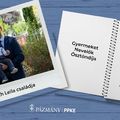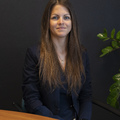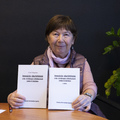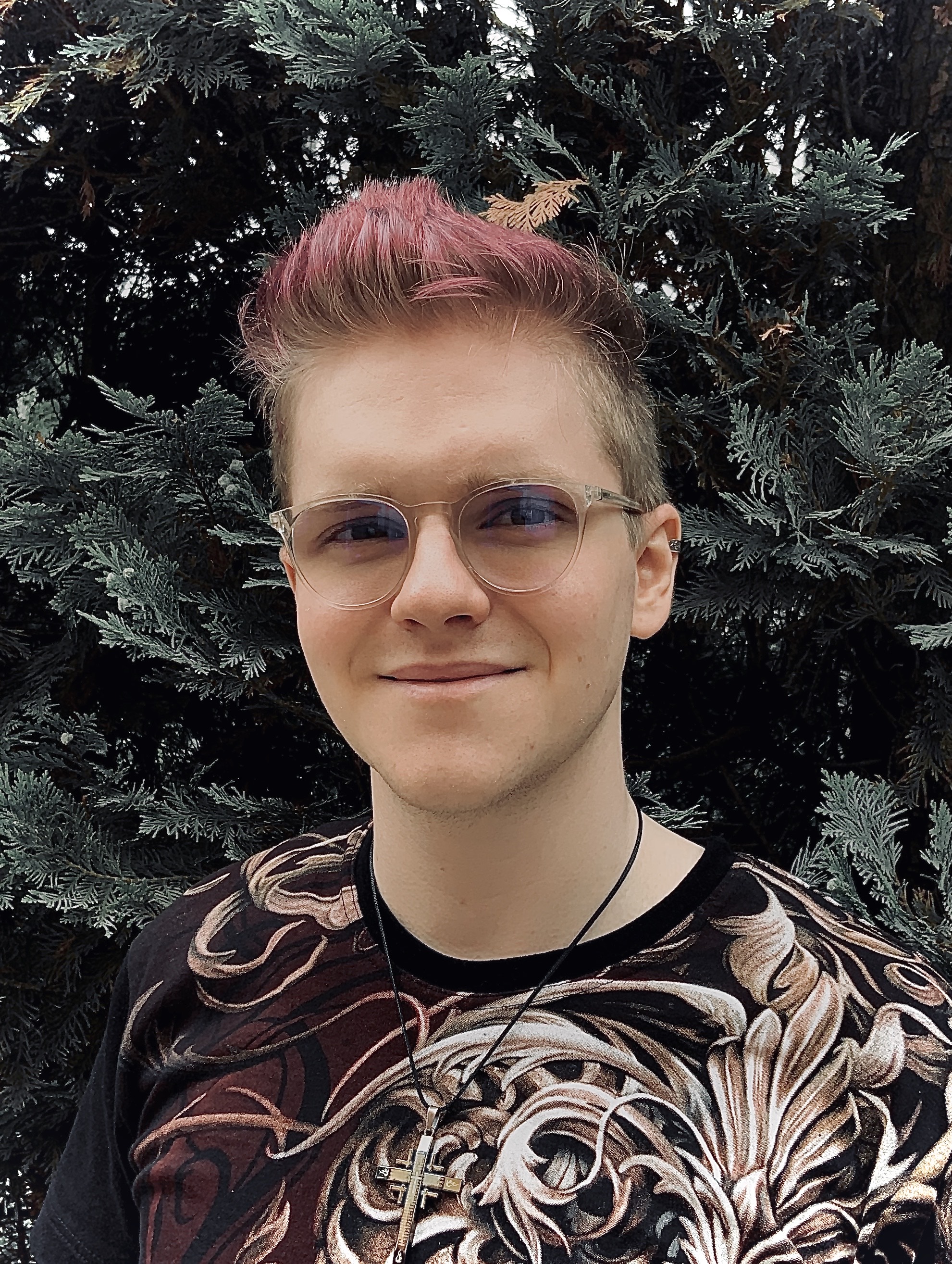 Németh Erik a Pázmány ITK Info-Bionika mérnöki MSc szakos hallgatója. Egyetemi tanulmányi mellett Lyonban dolgozik egy agykutató laboratóriumban. Erik nem az a tipikus agykutató, akit általában elképzelünk: saját bevallása szerint türelmetlen, energikus, végtelenül lelkesedik minden iránt, és élete több fontos döntésében is a rajzfilmek játszottak közre. A FameLab-nek, a világ vezető tudománykommunikációs versenyének második helyezettje vallja, hogy a tudomány mindenkié. Őt kérdeztük Pázmányos éveiről, kutatásairól, és terveiről.
Németh Erik a Pázmány ITK Info-Bionika mérnöki MSc szakos hallgatója. Egyetemi tanulmányi mellett Lyonban dolgozik egy agykutató laboratóriumban. Erik nem az a tipikus agykutató, akit általában elképzelünk: saját bevallása szerint türelmetlen, energikus, végtelenül lelkesedik minden iránt, és élete több fontos döntésében is a rajzfilmek játszottak közre. A FameLab-nek, a világ vezető tudománykommunikációs versenyének második helyezettje vallja, hogy a tudomány mindenkié. Őt kérdeztük Pázmányos éveiről, kutatásairól, és terveiről.
Mikor, minek kapcsán kezdett el érdeklődni az agykutatás iránt?
Tisztán emlékszem, hogy már az oviban is az a praktikus gyerek voltam, aki szívesen vásárolta fel a helyi könyvvásárok alatt azokat a könyveket, melyektől mások szabadulni próbáltak: könyveket az emberi test titkairól, a világűr rejtelmeiről, sőt, emlékszem, hogy egyszer még egy genetikáról szóló kötetet is sikerült beszereznem. Hogy tudós akartam lenni, az egyértelmű volt. A Varázslatos Iskolabusz rajzfilmek különc tanárnője, Miss Mici jó munkát végzett ezen a téren. Hogy mikor döntöttem az agykutatás mellet, már sokkal érdekesebb kérdés. Sokáig nem tudtam, melyik is az a tudományág, amiben a jövőmet el tudom képzelni, és bizony még az egyetemi éveim alatt is hosszas próba-szerencse játék volt rátalálni, mi is érdekel igazán. Képzelhetik, mennyire meglepődtem aztán, amikor egy általános iskolás osztálytalálkozómon egyik volt osztálytársam édesapja vicceskedve megkérdezte tőlem: „Na, lett-e belőled agykutató, ahogy azt harmadikban ígérted?” Erre csak egy széles mosollyal tudtam válaszolni.
Miért döntött úgy, hogy a Pázmány ITK-ra jelentkezik?
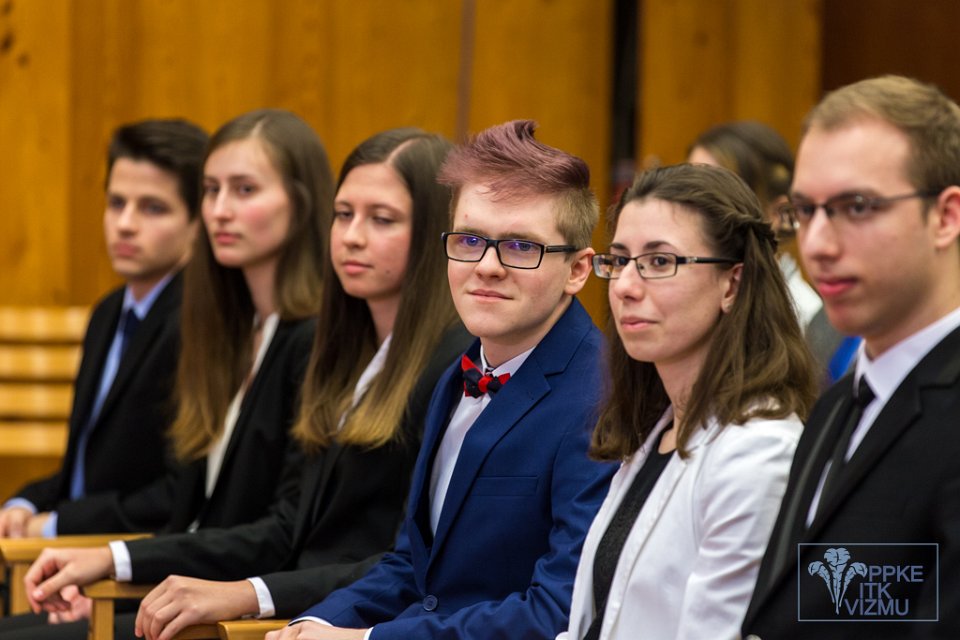 Az egyetemi felvételi igazi kínszenvedés volt. Biológiával akartam foglalkozni, de nem tudtam magamat orvosként elképzelni. Tanulni szerettem volna számítástechnikát, de távolról sem láttam magam az IT területén elhelyezkedni. Érdekelt a fizika, pláne a modern mérnöki megoldások, de nem hittem benne, hogy egy „szokványos” mérnökképzésben lenne a helyem. Addig húztam-halasztottam a döntést, mígnem a jelentkezési határidő előtti este – érett fiatal felnőtt lévén – elmentem moziba megnézni a Hős Hatost. (Lassan visszatérő motívummá válik a rajzfilm ebben az interjúban.) A történet egy fiktív egyetem robotika szakos hallgatójáról szólt, és én abban a pillanatban tudtam, hogy rám talált a leendő életem. A moziból kijőve vadul pötyögni kezdtem a keresőbe, és az első találat a Pázmány volt, nem egészen robotika, hanem még egy lépéssel közelebb a sci-fihez: bionika szakkal. Nem akartam hinni a szememnek. Aznap éjjel semmit sem aludtam. Hajnalig olvastam a bionika csodás világáról és a Pázmány nyújtotta lehetőségekről. Nem túlzás azt mondani, hogy az életem változott meg aznap éjjel. A nyílt napra már úgy érkeztem, hogy nem volt a fejemben kérdés.
Az egyetemi felvételi igazi kínszenvedés volt. Biológiával akartam foglalkozni, de nem tudtam magamat orvosként elképzelni. Tanulni szerettem volna számítástechnikát, de távolról sem láttam magam az IT területén elhelyezkedni. Érdekelt a fizika, pláne a modern mérnöki megoldások, de nem hittem benne, hogy egy „szokványos” mérnökképzésben lenne a helyem. Addig húztam-halasztottam a döntést, mígnem a jelentkezési határidő előtti este – érett fiatal felnőtt lévén – elmentem moziba megnézni a Hős Hatost. (Lassan visszatérő motívummá válik a rajzfilm ebben az interjúban.) A történet egy fiktív egyetem robotika szakos hallgatójáról szólt, és én abban a pillanatban tudtam, hogy rám talált a leendő életem. A moziból kijőve vadul pötyögni kezdtem a keresőbe, és az első találat a Pázmány volt, nem egészen robotika, hanem még egy lépéssel közelebb a sci-fihez: bionika szakkal. Nem akartam hinni a szememnek. Aznap éjjel semmit sem aludtam. Hajnalig olvastam a bionika csodás világáról és a Pázmány nyújtotta lehetőségekről. Nem túlzás azt mondani, hogy az életem változott meg aznap éjjel. A nyílt napra már úgy érkeztem, hogy nem volt a fejemben kérdés.
Pázmányos tanulmányai miként járultak hozzá kutatói munkájához?
Rengeteget köszönhetek a Pázmánynak, minden tekintetben. Mindenekelőtt ki kell emeljem, hogy az a családias légkör – tudom, talán elcsépelt szöveg, de igaz –, ami itt fogadott, második otthonommá tette a Kart. Az órák fantasztikusak voltak. Van valami a Pázmányos tanítási stílusban, ami megragadott: ahogy mi tanulunk, az nem az a klasszikus mérnöki út, de nem is teljesen elméleti. Mélyen megtanuljuk a matematikai modellezést, olyan mélyen, ami engem is végtelenül meglepett – közben mégis jut idő áramköröket építeni és laborban fehérjéket tisztítani. Többször kaptam már olyan visszajelzést, hogy a főnökömet meglepte a matematikai vagy biológiai rálátásom az aktuális projektre, és ez abszolút a Pázmány érdeme.
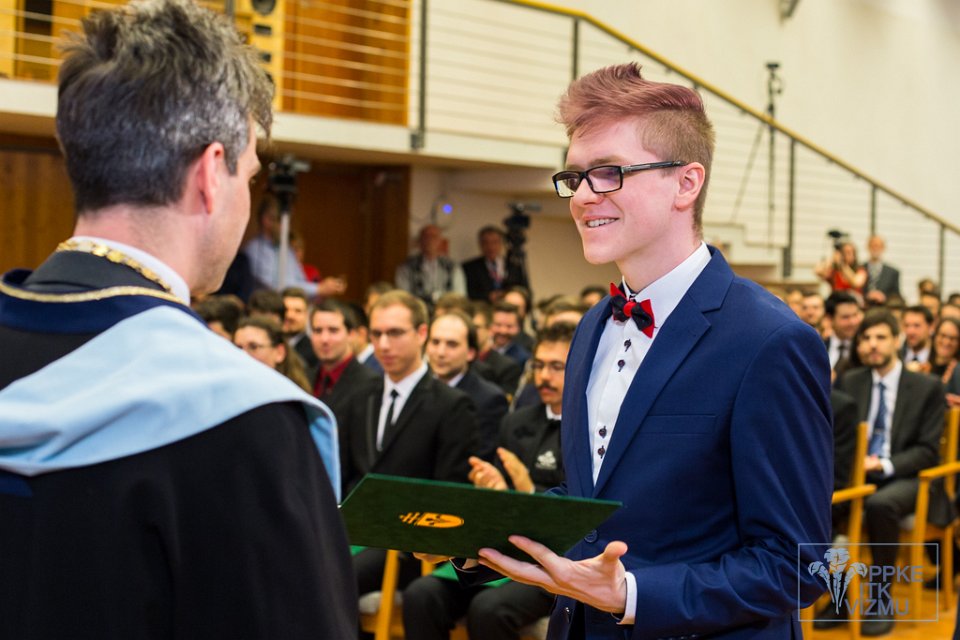 Nem szívesen emelek ki egy-egy oktatót vagy tárgyat az itt töltött éveimből, mert nem szeretném, ha úgy tűnne, mintha a többi tárgyam nem lett volna épp olyan fontos. Mindazonáltal szigorúan szakmai szemmel talán megválaszolhatom, mikor értek a legmaradandóbb benyomások. Mint már említettem, a matematika tárgy-blokkunk döbbenetesen erős. Bércesné Dr. Novák Ágnes folyamatos konzultálása és támogatása hatalmas benyomással volt rám, hasonlóképp Dr. Gerencsérné Dr. Vágó Zsuzsanna és Várdainé Kollár Judit minden tárgya kincs. A kutatásomhoz szükséges alaptudást a karunk biológia óráin szedtem össze. Dr. Lippai Mónika sejtbiológia előadásait nem felejtem el soha, de szakmailag a legnagyobb hatással Dr. Kalló Imre neurobiológia órái voltak rám, akárcsak Dr. Ulbert István elektrofiziológia előadásai. Végül nem szeretnék megfeledkezni az informatikáról sem: mindent, amit ezen a téren tudok, itt tanultam meg. Dr. Koller Miklós és Dr. Benedek Csaba megmutatták a számítástechnika szépségét. Végül a koronát a Mesterséges intelligencia és a Gépi tanulás tantárgyak során helyezte fel a nagy műre Dr. Karacs Kristóf, aki megmutatta, hogy születhet a statisztikából intelligencia. Tárgyai nagyban befolyásolták azt is, ahogy az agy működését vizsgálom. Utolsóként pedig szeretnék köszönetet mondani Dr. Gergely Annának, aki bár nem a karunk tanára, etológia órái nélkül sosem jutottam volna el oda, ahol most tartok.
Nem szívesen emelek ki egy-egy oktatót vagy tárgyat az itt töltött éveimből, mert nem szeretném, ha úgy tűnne, mintha a többi tárgyam nem lett volna épp olyan fontos. Mindazonáltal szigorúan szakmai szemmel talán megválaszolhatom, mikor értek a legmaradandóbb benyomások. Mint már említettem, a matematika tárgy-blokkunk döbbenetesen erős. Bércesné Dr. Novák Ágnes folyamatos konzultálása és támogatása hatalmas benyomással volt rám, hasonlóképp Dr. Gerencsérné Dr. Vágó Zsuzsanna és Várdainé Kollár Judit minden tárgya kincs. A kutatásomhoz szükséges alaptudást a karunk biológia óráin szedtem össze. Dr. Lippai Mónika sejtbiológia előadásait nem felejtem el soha, de szakmailag a legnagyobb hatással Dr. Kalló Imre neurobiológia órái voltak rám, akárcsak Dr. Ulbert István elektrofiziológia előadásai. Végül nem szeretnék megfeledkezni az informatikáról sem: mindent, amit ezen a téren tudok, itt tanultam meg. Dr. Koller Miklós és Dr. Benedek Csaba megmutatták a számítástechnika szépségét. Végül a koronát a Mesterséges intelligencia és a Gépi tanulás tantárgyak során helyezte fel a nagy műre Dr. Karacs Kristóf, aki megmutatta, hogy születhet a statisztikából intelligencia. Tárgyai nagyban befolyásolták azt is, ahogy az agy működését vizsgálom. Utolsóként pedig szeretnék köszönetet mondani Dr. Gergely Annának, aki bár nem a karunk tanára, etológia órái nélkül sosem jutottam volna el oda, ahol most tartok.
A Kar Tehetségprogramjában való részvétel milyen további lehetőségeket biztosított Önnek?
A tehetségprogram gyakorlatilag ITK VIP. Kedvemre lubickolhattam az előadásokban, korlátlanul vehettem fel, amit csak szerettem volna. Mi több, biztosított helyem volt a legjobb gyakorlatokon. Ha lehet, még fantasztikusabbá tette a Pázmányos élményt. Talán nem is csoda, hogy visszatekintve több mint egy félévnyi szabadon választható tárgyat végeztem el a BSc-s éveim alatt.
Nemrég részt vett a FameLab versenyen, ahol elnyerte a National Geographic különdíját, és az MTA második díját. Mesélne a versenyről és az előadásáról?
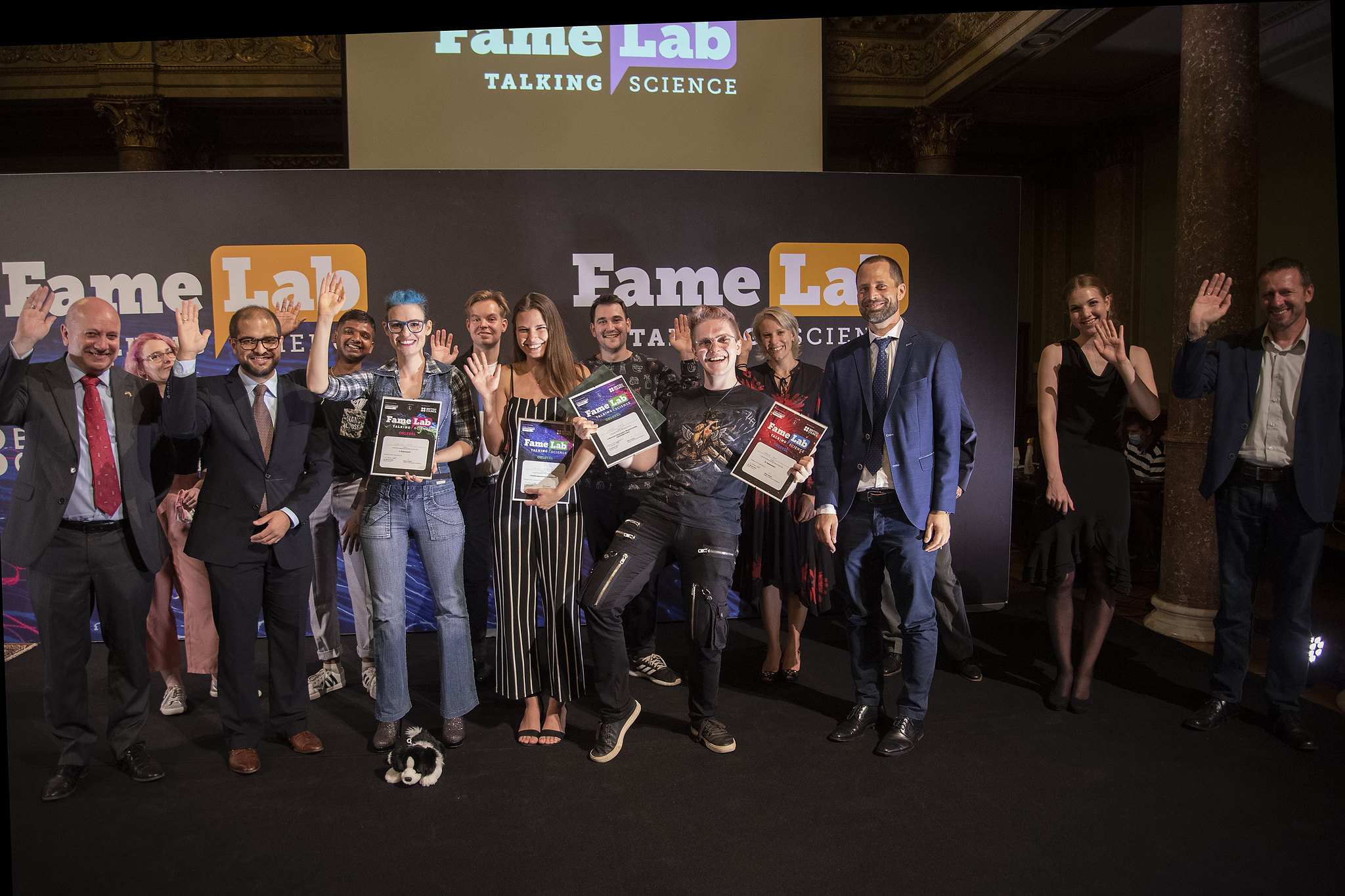 A FameLab egy vezető nemzetközi tudománykommunikációs verseny. Eredetileg Angliában rendezték meg, mára azonban közel 30 ország tudósai mérethetik meg magukat rajta. A verseny idén 4 fordulós volt: Magyarországon online került megrendezésre az elődöntő, melynek győztesei részt vehettek egy kétnapos mesterkurzuson a Mátrában – mondanom sem kell, megismételhetetlen élmény volt. A magyar döntőt az MTA székházában bonyolította le a Magyar Tudományos Akadémia és a British Council, itt adtam elő az „Útikalauz a mesterséges intelligencia szürkeállományába” című előadásomat… vagyis adtam volna elő, ha a technika ördöge nem szól közbe. Úgy terveztem, hogy egy csípős nyelvű géphanggal vitatkozván mutatom majd be a mesterséges neurális hálózatok működését. Ezek a biológiai neuron-hálózatokat utánzó modellek tették lehetővé korunk technológiai robbanását, legyen szó arcfelismerésről, filmajánlásról, önvezető autókról, vagy éppen a már-már rémisztő deep fake-ekről. Persze ahogy az előadásomba belekezdtem, hűtlen társam cserbenhagyott, és kénytelen voltam improvizálni a show nagyját. Különösebben nem izgultam akkor már, az esélytelenek nyugalmával fejeztem végül be a mondandómat. Végtelenül megdöbbentem, amikor kiderült: két díjat is elnyertem.
A FameLab egy vezető nemzetközi tudománykommunikációs verseny. Eredetileg Angliában rendezték meg, mára azonban közel 30 ország tudósai mérethetik meg magukat rajta. A verseny idén 4 fordulós volt: Magyarországon online került megrendezésre az elődöntő, melynek győztesei részt vehettek egy kétnapos mesterkurzuson a Mátrában – mondanom sem kell, megismételhetetlen élmény volt. A magyar döntőt az MTA székházában bonyolította le a Magyar Tudományos Akadémia és a British Council, itt adtam elő az „Útikalauz a mesterséges intelligencia szürkeállományába” című előadásomat… vagyis adtam volna elő, ha a technika ördöge nem szól közbe. Úgy terveztem, hogy egy csípős nyelvű géphanggal vitatkozván mutatom majd be a mesterséges neurális hálózatok működését. Ezek a biológiai neuron-hálózatokat utánzó modellek tették lehetővé korunk technológiai robbanását, legyen szó arcfelismerésről, filmajánlásról, önvezető autókról, vagy éppen a már-már rémisztő deep fake-ekről. Persze ahogy az előadásomba belekezdtem, hűtlen társam cserbenhagyott, és kénytelen voltam improvizálni a show nagyját. Különösebben nem izgultam akkor már, az esélytelenek nyugalmával fejeztem végül be a mondandómat. Végtelenül megdöbbentem, amikor kiderült: két díjat is elnyertem.
Az idei magyar győztes egyébként Vékony Kata, akinek az előadása frappáns, szórakoztató és lenyűgöző volt, és aki idén külföldön is képviselheti kis hazánkat a nagyközönség előtt – sajnos csak virtuálisan.
Ön szerint milyen tulajdonságok szükségesek ahhoz, hogy valaki jó kutatóvá váljon?
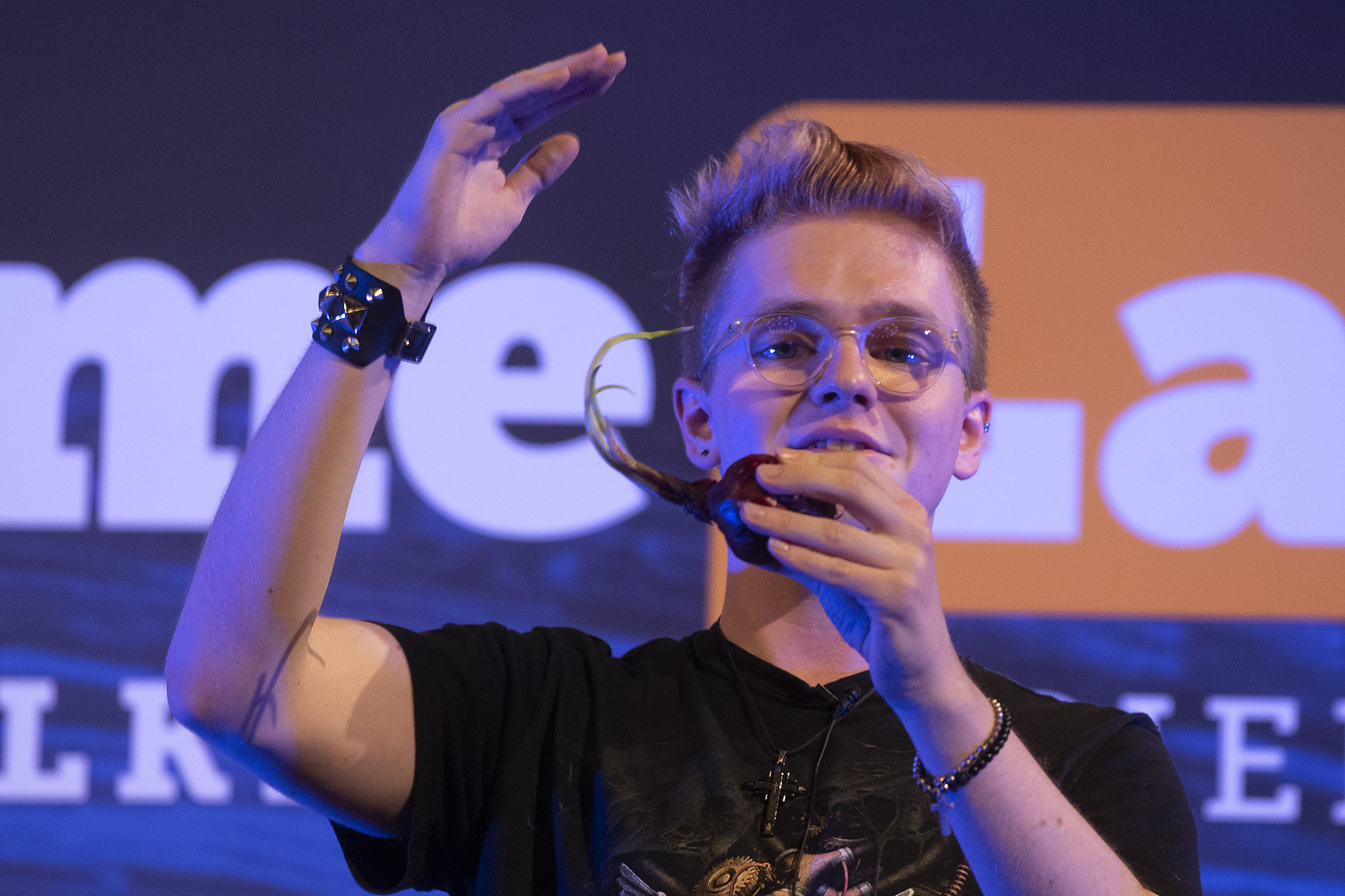 Ez a kérdés csalt csak igazán mosolyt az arcomra. Ha öt évvel ezelőtt megkérdeznek, milyen az igazi kutató, azt mondom: türelmes, csendes, rendszerezett és végtelenül komoly. Na, hát én türelmetlen vagyok, hangos, energikus, és hagyom, hogy rajzfilmek döntsék el az életem nagy kérdéseit (mondtam, hogy visszatér még ez a téma). Valahogy mégis kutató lettem. Hogy mi a titok? Szerintem a lelkesedés. Nem tudom magam elképzelni a tudományon kívül – ez egyszerűen lehetetlen. Tudósként kelek fel, és tudósként fekszem le, ha akarom, ha nem. Még a rajzfilmeket is tudósként nézem.
Ez a kérdés csalt csak igazán mosolyt az arcomra. Ha öt évvel ezelőtt megkérdeznek, milyen az igazi kutató, azt mondom: türelmes, csendes, rendszerezett és végtelenül komoly. Na, hát én türelmetlen vagyok, hangos, energikus, és hagyom, hogy rajzfilmek döntsék el az életem nagy kérdéseit (mondtam, hogy visszatér még ez a téma). Valahogy mégis kutató lettem. Hogy mi a titok? Szerintem a lelkesedés. Nem tudom magam elképzelni a tudományon kívül – ez egyszerűen lehetetlen. Tudósként kelek fel, és tudósként fekszem le, ha akarom, ha nem. Még a rajzfilmeket is tudósként nézem.
Milyen tervei vannak a jövőre nézve?
Először is, fél éven belül lezárul az életem az ITK-n. Keserédes gondolat ez, nagyon fontos számomra a Kar, és mindenki, aki ott tanul és dolgozik. Szomorú belegondolnom, hogy az utolsó időszakomat távol kellett töltenem a járvány miatt.
Az utolsó félévemet reményeim szerint Lyonban töltöm majd, ahol befejezhetem a kutatásomat. Ebből írnék egy szakdolgozatot tavasz végéig. Közben az MTA jóvoltából a FameLab magyarországi második helyezettjeként a nyereményemet szeretném abba fektetni, hogy létrehozzak egy tudománykommunikációval foglalkozó YouTube csatornát, és megmutassam: a tudomány tényleg mindenkié.
A következő évekre aztán számtalan tervem van. Szeretnék utazni, találtam pár igazán kecsegtető poszt-graduális ösztöndíjat ilyen célra. Szeretnék doktorizni is, bár ki tudja, mikor, hol, és pontosan miből. Ha mindent véghez viszek, ami most a fejemben van, akkor nem fogok unatkozni az elkövetkező… legalább tíz évben.
_______________________________________
„Science is for everyone” – Interview with Erik Németh brain researcher, student of Pázmány FITB
Erik Németh studies Info-Bionics Engineering MSc Pázmány FITB. Besides his university studies, he works in a brain research laboratory in Lyon, France. Erik is not the typical brain researcher we usually imagine: he admits to be impatient, loud, somewhat impulsive, with a profound enthusiasm about a lot of things, who lets cartoons play a decisive role in the important decisions of his life. The first runner-up of FameLab, the world’s leading science communication competition wants to show the world that science is for everyone. We asked him about his studies, research, and plans.
When and how did you first become interested in brain research?
I remember clearly how practical of a kid I was in my kindergarten years. During the book fairs, I was the one buying all the volumes nobody wanted. The ones about the secrets of the human body, or the mysteries of space, once I could even put my hands on a volume about genetics for kids. There was no doubt that I would become a scientist. The eccentric Miss Frizzle in the Magic Schoolbus series made sure of that. But to address the exact time I cast my final vote on brain research – it’s hard to tell, really. For quite a while I struggled figuring out what field of science I could see myself in, and even during my years at college I had to play a game of trial-and-error to eventually see what tickled my fancy. You can imagine my surprise at a primary school class reunion where one of my former classmates’ father asked me jokingly: ’Have you become a brain researcher as you had promised in third grade?’ To that I could only answer with a wide grin.
Why did you choose Pázmány FITB for your studies?
Finding a university to apply to was a pain in the back for me. I knew I wanted to work in the field of biology, but I didn’t see myself as a doctor. I wanted to study IT, but I could never imagine myself as a programmer. I always loved Physics, especially modern engineering solutions, yet I never believed that I’d enjoy a regular engineering course. I couldn’t make up my mind, I kept stalling and stalling until the day before the application deadline came. Me, being a mature young adult that I am, went to the cinema that night to watch Big Hero Six. (It’s funny how cartoons are becoming the recurring motive of this interview.) The movie was about this young boy studying robotics at a fictional university – and I instantly knew I had found my call. On my way out I was already googling vigorously, and the first result was none else but Pázmány. Not robotics, per se, but something even crazier: bionics. I couldn’t believe my eyes. I had no sleep that night. I read up on the amazing world of bionics and all the opportunities Pázmány could grant me. Without hesitation I can say that my life was changed that day. By the time I visited Pázmány on the Open Day, I had no questions in my head anymore.
In what way did your studies at Pázmány University contribute to your research work?
I am thankful to Pázmány in more than one way. First of all, I must say that the campus really felt like a home away from home and the Faculty became my second family – I know it’s cheesy, but it’s true. There’s just something in the Pázmány-way of teaching that caught me: the way we study isn’t that of a classical engineer, but it’s not completely theoretical either. We learn mathematical modelling thoroughly – in more detail than I could ever have imagined – but at the same time we do build circuits and purify proteins in the lab, too. I have received positive feedback from my boss quite a few times on my mathematical or biological insight, and I must say the credit goes to Pázmány for that.
When it comes to my classes, I wouldn’t want to pick any favorites. I don’t want to choose a subject or a lecturer over the other as all my subjects were needed for the greater picture. Yet, on the account of my professional work, and strictly that, I might answer who made the longest-lasting impressions on me. As I said before, our mathematics curriculum is astonishingly thorough. The consultations of Dr. Ágnes Bérces and her constant support were a huge inspiration. Similarly, the classes of Dr. Zsuzsanna Gerencsérné and Judit Várdai are real gems. As for my research, I was provided a solid basis in biology upon which I can build my work. Dr. Mónika Lippai gave us an unforgettable insight into the inner workings of a cell. But my biggest push was that of Dr. Imre Kalló and prof. István Ulbert, who both taught me different aspects of neurobiology. And last but not least, computer science. I would like to thank Dr. Miklós Koller and Dr. Csaba Benedek, without whom I would have never found out the beauty of computer science. IT gave me a completely new perspective, allowing me to look at brain functions in a different way. A turning point in this process was two subjects of Dr. Kristóf Karacs, AI and Machine Learning, which helped me finally grasp the power of statistics in learning. Finally, I would like to thank Dr. Anna Gergely, who is not a professor of our faculty, yet without her classes on ethology I wouldn’t be where I am now.
What extra opportunities has your participation in the Faculty Talent Program provided to you?
The Talent Program is technically a “FITB VIP”. I was granted the opportunity to a limitless stream of classes, guaranteed place in the most popular practical classes and a lot more. It made the Pázmány-experience even better, if that’s possible. No wonder that I took more than an extra semester’s worth of optional classes during my Bachelor’s program.
Recently, you were the first runner-up of the Hungarian Academy of Sciences at the FameLab competition, also receiving the Special Prize of the National Geographic. Can you tell us about the competition and your presentation?
FameLab is a leading international competition on science communication. It was originally organized in the UK, but as of right now scientists form more than 30 countries can compete with each other for the grand prize. The competition this year consists of 4 rounds. The Hungarian semi-finals were held online, and the winners were granted a masterclass in the beautiful mountains of Mátra. Needless to say, it was unforgettable. As for the Hungarian Final, it was organized by the Hungarian Academy of Sciences (MTA) and the British Council in the MTA headquarters. Here I presented my talk „A Brain Researcher’s Guide to the Gray Matter of AI”—or would have presented it anyway hadn’t my prop gone haywire. My plan was that I would casually converse with a rather sarcastic disembodied robot voice with whom I would introduce the audience to the idea of artificial neural networks. These biologically inspired computational models enabled the quick development of modern algorithmic solutions from automatic face recognition through movie recommendations and self-driving cars to the almost scary deep fake, and more. But of course as a funny twist of fate, my disloyal companion walked out on me forcing me to ad-lib my presentation from the beginning to the end. By the time I finished, my anxiety was replaced by the certainty of having lost my one chance at winning, so I wasn’t worried too much. You can imagine my surprise when I was given not one, but two prizes in the end.
This year’s Hungarian winner by the way is Kata Vékony, whose enthusiasm, energy, humor and professional insight blew us all away. She will represent our country in front of the jury of the international rounds – unfortunately, of course, only virtually.
What attributes do you think are required to become a good researcher?
This question put a smile on my face. If you had asked me five years ago, I would have answered something along the lines of ’researchers are patient, quiet people, who are always orderly and never unprofessional’. Now, let me tell you this: I’m everything but those things. I am impatient, loud, somewhat impulsive and I let cartoons decide my fate (I’ve warned you it would be a recurring theme). And yet here I am, living my dream. What’s the secret? Passion, I think. I can’t see myself outside of science – it’s just impossible. I wake up as a scientist, go to bed as a scientist, even watch cartoons as a scientist. It’s a way of thinking I’d say.
What is your dream as a researcher?
To begin with, my life as the student of Pázmány will come to an end in six months. It’s a bittersweet thought, really, I will miss the Faculty and everyone there gravely. It is especially sad that, due to the pandemic, I have to spend my last semesters away from the campus.
I am nonetheless hopeful that I can spend my last semester in Lyon where I can wrap up my research. I am hoping to write my thesis based on it by the end of spring. In the meantime, I would like to invest my prize provided by MTA, received for the second place on FameLab, to create a YouTube channel and show the world that science is for everyone.
As for the upcoming years, I have several different scenarios in my head. I would like to travel, and I have already found some very attractive scholarships for postgraduates. I would like to acquire a PhD as well, although I don’t know the exact topic or place yet. Honestly, if I manage to do everything I have imagined, I won’t run out of projects for at least the upcoming ten years.
Készítette: Pázmány ITK / Vödrös Zsófia
Képek: Németh Erik; PPKE VM Stúdió; mta.hu/Szigeti Tamás

